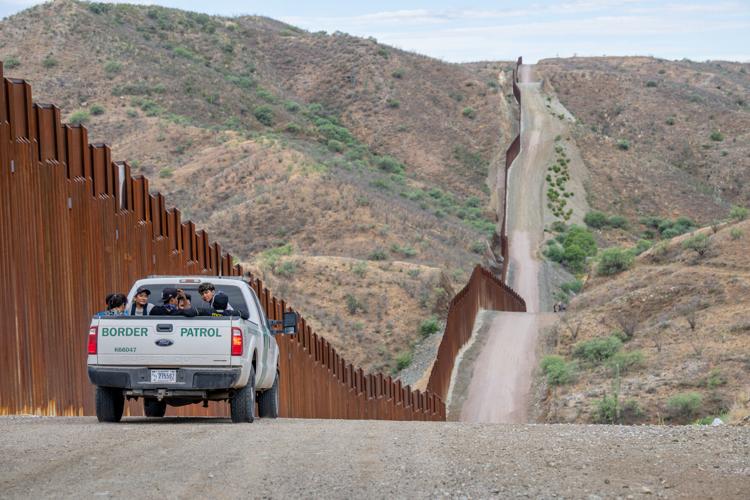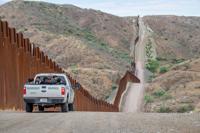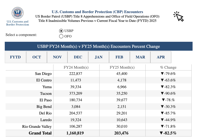
RUBY, ARIZONA - JUNE 24: Migrants seeking asylum from Central and South America ride in the back of a border patrol vehicle after being apprehended by U.S. Customs and Border protection officers after illegally crossing over into the U.S. on June 24, 2024 in Ruby, Arizona.
Nogales, Arizona – Border officials issued a warning to immigrants who cross the border illegally: they will not only be detained and deported, but will also face charges for having entered the United States illegally.
“The days of catch and release are over,” said Jesús Vasavilbaso, Border Patrol agent and spokesperson for the Tucson Sector.
On Jan. 20, the same date President Donald Trump took office, U.S. Customs and Border Protection (CBP) announced it would end the catch and release policy, which has been in place in the U.S. since the 1990s.
This policy allows migrants who enter the U.S. illegally to be temporarily released on U.S. soil after being apprehended by CBP. During this period, they can remain in the country until their immigration case is processed.
However, since Trump's return and his strong crackdown on unauthorized immigration, the policy was discontinued, leading to an increase in detentions of migrants attempting to cross the southern border.
During a news conference, held in Spanish on Thursday near the southern border in Nogales, Arizona, Vasavilbaso warned that these individuals will be arrested, face criminal proceedings and then deported.
A change that has also been imposed under the Trump administration is that migrants from Mexico will no longer be deported at the border where they were detained, but will instead be sent to central Mexico or southern Mexico, near the border with Guatemala. This would dissuade that same person from attempting to cross back into the U.S., Vasavilbaso said.
A drop in migrant encounters
Although the measure of returning deported migrants to southern Mexico is intended to prevent them from crossing again, some have returned to the border, specifically to Nogales, Sonora, to attempt to cross again or to stay in that city to be close to relatives living in Arizona, according to attorney Francisco Loureiro, director of the San Juan Bosco migrant shelter in Nogales, Sonora, which has provided lodging, food, basic medical care and legal guidance to migrants since 1982.
Loureiro considered this new protocol far too harsh, especially for those who arrive in Mexico from other countries intending to cross into the U.S. However, he said the CBP's announcement of such strict measures could be favorable to prevent further violence and death in the desert.
Between 1990 and 2016, over 6,000 migrants have died attempting to cross into the U.S. — 2,776 of them while navigating the harsh terrain of the Sonoran Desert which Arizona and Sonora share.
“We've received people who have already been taken to (Mexico’s) southern border and are already back — they only last three or four days before being back at the (U.S.) border,” the shelter director said.

Migrant encounter data at southwest border patrol sectors.
Vasavilbaso said that migrant encounters in the Tucson Sector have dropped by 90%, compared to the previous fiscal year. So far this year, Border Patrol has recorded over 35,000 encounters, while in the same period in 2024, they recorded over 373,000 encounters.
The Tucson Sector is a 272-mile patrol area that begins in Douglas, Arizona, on the Arizona-New Mexico border line and extends to the Pima-Yuma County border.
Loureiro agreed that the number of migrants they have received in recent days has decreased significantly, both in transit and in deportations. They average about 10 to 15 people per day at that shelter, down from an average of 200 people per day before the Trump administration enacted new policies.
Warning comes with promise of criminal charges
Attorney Luis Fernando Parra, who has 15 years of experience litigating in federal immigration courts, primarily in Tucson, Arizona, explained to CALÓ News the different charges and penalties that a migrant can face for unauthorized entry or re-entry into the United States.
Parra explained that a migrant crossing the border for the first time can be charged under Section 1325 of the United States Federal Code, which refers to the illegal entry of a person with no criminal record. This is a misdemeanor offense, and a judge can hand down a sentence of up to six months in prison.
If a person reenters the country illegally after being deported, they can be charged with a more serious crime under Section 1326. The punishment depends on how many times that crime has been committed, Parra said. For example, if a person has reentered the country illegally twice, they can receive a prison sentence of approximately six months, but if it's the third time, it can be longer, he said.
There are also cases with harsher penalties, such as when a person who has committed a serious crime in the U.S., such as abuse or homicide, reenters the country in an unauthorized manner. These cases, Parra said, are handled very seriously in federal court, and the judge can impose prison sentences ranging from two to 20 years.
César Barrón is an independent reporter covering the transnational communities of Ambos Nogales. He has over 20 years of experience covering the Sonoran communities.












(0) comments
Welcome to the discussion.
Log In
Keep it Clean. Please avoid obscene, vulgar, lewd, racist or sexually-oriented language.
PLEASE TURN OFF YOUR CAPS LOCK.
Don't Threaten. Threats of harming another person will not be tolerated.
Be Truthful. Don't knowingly lie about anyone or anything.
Be Nice. No racism, sexism or any sort of -ism that is degrading to another person.
Be Proactive. Use the 'Report' link on each comment to let us know of abusive posts.
Share with Us. We'd love to hear eyewitness accounts, the history behind an article.